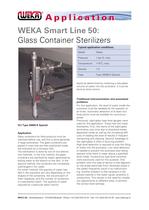 Website:
WEKA
Website:
WEKA
Group: Arca Group
Catalog excerpts

WEKA Smart Line 50: Glass Container Sterilizers Typical application conditions Media Water Pressure 1 bar G, max. Temperature 110°C, max. Density 1.0 Type Type 34000-K Special easily be determined by metering a calculated volume of water into the autoclave: it must be done by level control. VLI Type 34000-K Special Application Glass containers for food products must be sterilized before use, and this is done generally in large autoclaves. The glass containers are placed in trays that are then positioned inside the autoclave by a conveyor belt. The sterilization is done by one of two alternative methods. In the first method, the glass containers are sterilized by steam generated by boiling water at the bottom of the tank. In the second method, the containers are completely submerged in hot water. For either method, the quantity of water needed in the autoclave can vary depending on the shapes of the containers, the volume each of them displaces, and the number of containers in a sterilization batch. The quantity of water required for a particular batch cannot Traditional instrumentation and associated problems For this application, the level of water inside the autoclave must be readable by the operator at all times. Automatic detection of at least two level points must be available for control purposes. Previously, sight-glass type level gauges were used for this application. These had two major drawbacks. First, the clarity of the sight-glass diminishes over time due to dissolved matter deposited inside as well as the increasing difficulty of reading the level of results in frequent dismantling and cleaning. Second, breakage of the sight-glass is often a recurring problem. High level detection is required to stop the filling of water into the autoclave. Low level detection is needed to prevent the autoclave door being opened while there is water above a specified level inside. Conductivity type level switches were previously used for this purpose. One problem with this type of device is that deposits on the probe electrode (from dissolved solids in the water) frequently result in its malfunctioning. Another problem is that variations in dissolved material in the water cause variations in conductivity. This results in the need for installation adjustments at different sites, to achieve the correct level settings. WEKA AG · Schürlistrasse 8 · CH-8344 Bäretswil · Phone ++41 (0)43 833 43 43 · Fax ++41 (0)43 833 43 29 · www.weka-ag.ch
Open the catalog to page 1
WEKA advantages The WEKA Type 34000-A Special is optimized for this application. Its float chamber has a threaded service plug at the top and a drain plug at the bottom. Dissolved matter in the water never affects the readability of this WEKA Level Indicator because the indication rail assembly is totally isolated from the float chamber containing the media and magnetic float. Periodic cleaning of the wetted parts of this level instrument, usually necessary in food industry applications, is easy with the WEKA 34000-A. The top cap and bottom drain plugs can be removed and replaced very...
Open the catalog to page 2All WEKA catalogs and technical brochures
-
Control and shut-off valves
8 Pages
-
Level Measurement
8 Pages
-
Transmitter Series XT-800R
4 Pages
-
Top of Tank Line SS & Plastik
15 Pages
-
Visual Level Indicator VLI
8 Pages
-
Visual Level Indicator CuNi
2 Pages
-
Tank Level Instruments TLI
6 Pages
-
Heat Tracing 20060307 70-80
1 Pages
Archived catalogs
-
Transmitter Series XT-800R
4 Pages
-
VLI
8 Pages
-
DB industrial series
21 Pages
-
Weka flyer tli
6 Pages
-
WEKA flyer
4 Pages
-
Textile Dyeing
2 Pages
-
Petrochemical Industry
3 Pages
-
Refrigeration
2 Pages
































